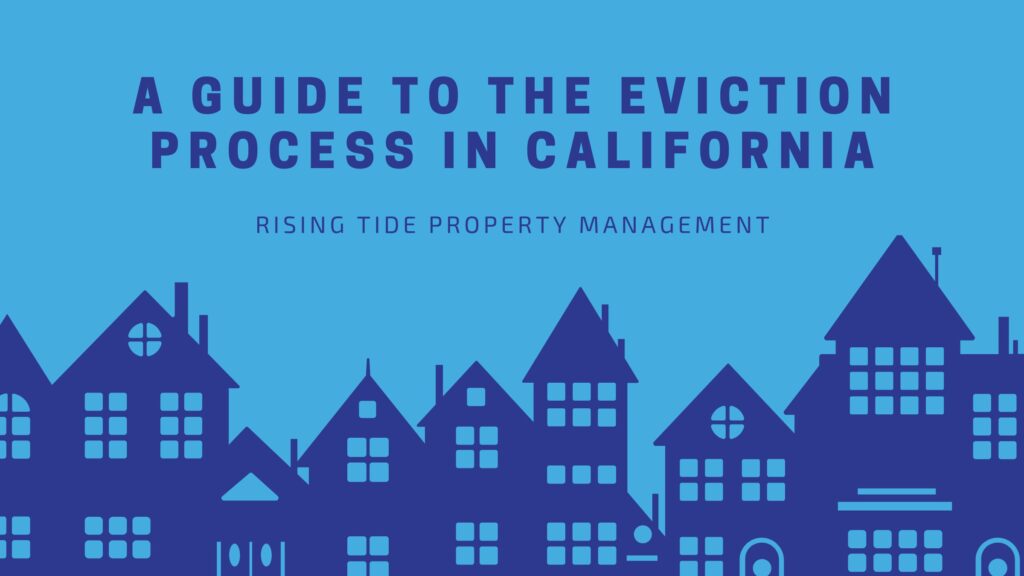A Guide to the Eviction Process in California
Evictions are stressful and can be financially draining for landlords. Yet, there are situations where eviction is the only viable option. Understanding landlord-tenant laws along with eviction process laws is crucial to protect yourself and your property.
This guide will help landlords in California understand the eviction process thoroughly, ensuring compliance and minimizing complications.
Grounds for an Eviction in California
In California, a landlord cannot legally evict a tenant without cause. Legal grounds to evict include:
Nonpayment of Rent
If a tenant fails to pay rent on time, the landlord can issue a 3-day notice to pay or quit.
Staying After the Lease Ends
Tenants who remain on the property after the lease has expired can be given a 30-day or 60-day notice to vacate, depending on the duration of their tenancy.
Violating Lease Terms
A 3-day notice to perform covenants or quit can be issued if a tenant violates any lease terms.
Committing Illegal Activity
Immediate eviction can occur if a tenant is involved in illegal activities on the property.
Notice for Lease Termination With Legal Cause
California law requires landlords to provide proper notice to tenants before initiating an eviction. The type of notice depends on the reason for eviction:
3-Day Notice to Pay Rent or Quit
This notice is issued when rent is not paid on time, giving the tenant three days to pay the overdue rent or move out.

30/60-Day Notice to Vacate
This is given to tenants who stay beyond their lease term. In California, a 30-day notice applies to those with a tenancy of less than one year, while a 60-day notice is for those with a tenancy of one year or more.
3-Day Notice to Perform Covenants or Quit
For minor lease violations, this notice allows tenants three days to remedy the breach or vacate.
3-Day Notice to Quit
This is used when illegal activity occurs. It provides the tenant with three days to move out without the option to cure the issue.
Eviction Process: Step-By-Step Guide
The eviction process in California consists of several steps:
Step 1: Serving the Tenant With an Eviction Notice
The first step is to serve the tenant with the appropriate notice. This can be done through:
• Personal delivery to the tenant.
• Delivery to a person of suitable age at the tenant’s residence or workplace, followed by mailing the notice to the tenant’s address.
• Posting the notice in a conspicuous place on the property and mailing it to the tenant’s address.
Keeping proof of service, such as a signed service declaration or a return receipt, is essential.
Step 2: Filing a Complaint With the Court
If the tenant doesn’t comply with the notice, the landlord can file an unlawful detainer lawsuit with the Superior Court. The complaint should include:
• Landlord and tenant contact details.
• The rental property address.
• Information on the lease agreement.
• Grounds for eviction.
• Proof of notice served.
Attach relevant documents, such as a copy of the lease agreement and the eviction notice.

Step 3: Serving the Summons and Complaint to the Tenant
Once the lawsuit is filed, the court issues a summons and complaint, which must be served on the tenant. Anyone who is at least 18 years old, such as a sheriff or a professional process server, can do this.
Step 4: Attending the Court Hearing
If the tenant contests the eviction, a court hearing will be scheduled. Both the tenant and landlord will present their cases. The court will then judge based on the evidence and arguments presented.
Step 5: Issuing a Writ of Possession
A writ of possession will be issued if the court rules in favor of the landlord. This legal document authorizes the sheriff to remove the tenant from the property.
Step 6: The Eviction
The final step involves the sheriff carrying out the physical eviction of the tenant. The tenant will be given a specific period to vacate the property voluntarily. If they fail to comply, the sheriff will enforce the writ of possession, removing the tenant and their belongings from the premises.
Any belongings left behind by the tenant will remain and may be subject to a lien, allowing the landlord to claim them for damages that exceed the unpaid rent or security deposit.
Tenant Eviction Defenses in California
Tenants have the right to contest an eviction by presenting defenses, which may include:
Improper Notice
Claiming the landlord did not follow the correct notice procedures.
Retaliatory Eviction
Arguing that the eviction is in retaliation for the tenant exercising their legal rights, such as reporting health and safety violations.

Discrimination
Alleging that the eviction is based on discriminatory reasons, violating fair housing laws.
Repair and Deduct
Stating that the tenant withheld rent due to uninhabitable living conditions, which the landlord failed to address.
Illegal Evictions in California
Specific actions by landlords are considered illegal and can result in penalties:
Self-Help Evictions
Landlords cannot forcibly remove tenants by:
• Changing the locks.
• Shutting off utilities.
• Removing tenant belongings.
Retaliatory Evictions
It is illegal to evict a tenant in response to them exercising their legal rights, such as:
• Complaining about property issues.
• Joining a tenant union.
• Pursuing legal action against the landlord.
Prohibited Local Eviction Criteria
Recent changes in California law prohibit local governments from regulating evictions based on:
• Alleged arrest or unlawful conduct not proven in court.
• Criminal background checks.
• Certificates of occupancy obtained by tenants.
• Blacklist registries for past evictions or non-criminal conduct.
Bottom Line
Understanding and adhering to the eviction process in California is crucial for landlords. By following the legal requirements and proper procedures, landlords can protect their property rights while minimizing disputes and legal complications.
If you have questions or need assistance with an eviction, consider hiring Rising Tide Property Management. We are dedicated to assisting you with all aspects of your property management needs.
Disclaimer: Please note that the information provided in this blog is intended for general guidance and should not be considered as a replacement for professional legal advice. It is important to be aware that laws pertaining to property management may change, rendering this information outdated by the time you read it.

